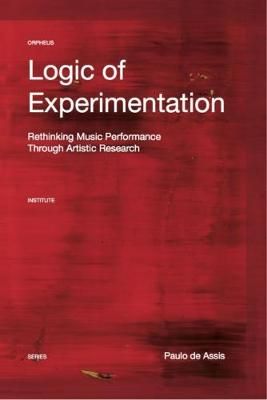
Logic of Experimentation: Reshaping Music Performance in and through Artistic Research
- Author: Assis, Paulo de
Book
$55.75Out of stock at the UK distributor
Contents
- Preface: A Transdisciplinary Conjuncture
- Introduction: Experimentation versus Interpretation
- Part 1. Assemblage Theory for Music
- Chapter 1: Virtual Works—Actual Things
- Rasch — The limits of music philosophy and the role of artistic
- research — Music ontologies: some problems — Beyond
- transcendence: approaching a Deleuzian ontology — Virtual
- works, actual things: towards a new image of musical work —
- Strata — Rasch25: . . . vers la nuit
- Chapter 2 : Assemblage, Strata, Diagram
- Musical works as assemblages — Agencement, logic of assemblage,
- assemblage theory — Intermezzo: a note on translation —
- From structure to assemblage — Strata — Diagram — Logic of
- assemblage
- Part 2: Experimental Systems in Music
- Chapter 3: Experimental Systems and Artistic Research
- An epistemology for artistic research? — A methodology for
- artistic research — Hans-Jörg Rheinberger’s experimental systems
- — Thought collective and ensembles of experimental systems:
- MusicExperiment21 — Series of experiments and modules of
- research
- Chapter 4: Epistemic Complexity in Music Performance
- Complexity and epistemic complexity — Epistemic complexity
- in biology — Epistemic complexity in technology — Epistemic
- complexity in music — Experimentation in music performance:
- how to make the future?
- Part 3. Beyond Interpretation: Bodies-in-Action
- Chapter 5: Transduction and the Body as a Transducer
- Transduction in music performance: relaying f lows of intensities;
- — Gilbert Simondon’s various definitions of transduction —
- Discharge (potentiality); — Passage (time and temporality);
- — Energy (thermodynamics): potential, scales, entropy
- — Information theory: structural germs and singularities
- (structuration) — Haecceity: from haecceitas (Duns Scotus) to
- eccéité (Simondon) to heccéité (Deleuze and Guattari) to microhaecceity
- — Topology: in-formation — Corporeality: somatic
- transduction — Permanent transduction: being-in-the-world and
- fluctuatio animi; 11. Conclusion
- Chapter 6: Rasch26 : The Somatheme
- The somatheme — Roland Barthes at the piano: musica practica —
- The impact of Julia Kristeva: phenotext and genotext —
- New musical concepts: geno-song, pheno-song, somatheme —
- Intermezzo: fourteen somathemes — The impact of Jacques
- Lacan: signifier and jouissance — Lacan’s desire — Situating the
- somatheme within Lacan’s graphs of desire — Conclusion: artistic
- research and transdisciplinarity
- Part 4. A New Ethics of Performance
- Chapter 7: The Emancipated Performer:
- Musical Renderings and Power Relations
- Music performance and power relations — The dominant image
- of work and the problem of interpretation — The tacit authorities:
- Deleuze’s “Postscript on the Societies of Control” — Nietzsche’s
- three modes of relation to history: monumental, antiquarian,
- critical — A new image of work — The emancipated performer
- Chapter 8. . . . at the borders of time that surround our presence . . .
- What is the contemporary? — Agamben’s contemporary: Barthes
- reading Nietzsche — Nietzsche’s untimely: lost in translation —
- . . . at the border of time that surrounds our presence . . . — Artistic
- research as the carrier of the contemporary
- Appendix 1: Beyond Urtext: A Dynamic Conception of Musical Editing
- On notation and time — The urtext era — Urtext editions: an
- epistemological obstacle — Critical editing of music and different
- types of editions — Music editing and performance practice: a
- dynamic conception
- Appendix 2: The Conditions of Creation and the Haecceity of Musical Material: Philosophical-Aesthetic Convergences between Helmut Lachenmann and Gilles Deleuze
- Helmut Lachenmann and Gilles Deleuze: an unconnected
- connection — Helmut Lachenmann: toward an aestheticostructural
- methodology — Helmut Lachenmann’s three “theses”
- on composing — Gilles Deleuze’s diagnostic function of art, capture
- of forces, and body without organs: first convergences with Helmut
- Lachenmann — Helmut Lachenmann’s four conditions of the
- musical material — Gilles Deleuze’s opinion, corporeity, fold, and
- latitude: further convergences with Helmut Lachenmann — The
- conditions of creation and the haecceity of musical material: a
- philosophical-aesthetic Erewhon
- Acknowledgements
- Index


